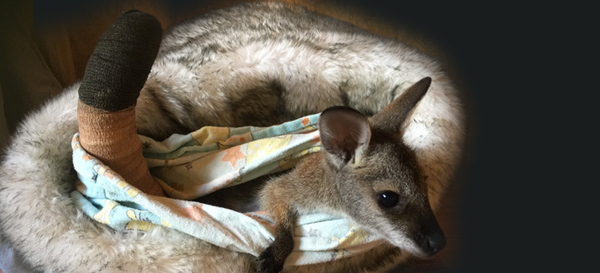About the Sanctuary
Covering 33 hectares and surrounded by State forest and National park, the sanctuary was established in 2015 and has been set up to care for injured and orphaned wildlife - primarily kangaroos and wallabies.
On 1st February 2020 during the black summer bushfires, 3 major out of control wildfires burnt and destroyed the sanctuary. We stayed to defend and protect the animals, however we were forced to evacuate when the fires became too hot to survive. We returned 2 days later and began rescuing and treating the survivors. Despite this setback, we will continue to do what we can to help our wildlife and have started the long process of rebuilding the sanctuary with the help from generous people who care about Australia's unique wildlife.
Over 90% of the sanctuary has been "locked away" in perpetuity for conservation and for the benefit of wildlife under agreement with the NSW Government Biodiversity Conservation Trust, which protects the property's ecosystems and wildlife from development, logging, farming and hunting.
The sanctuary is a safe release site for rehabilitated wildlife and includes purpose built fencing to keep out feral animals, as well as macropod enclosures and joey enclosures to provide safety for them when recovering from injury and sickness. Shortly after the black summer fires, HSI Australia generously funded an emergency triage centre, specifically to help injured wildlife here and for use in future wildfires. The triage centre has been instrumental in ensuring local wildlife have the best chance of recovery.
The sanctuary is registered with the Australian Charities and Not-for-profits Commission (ACNC), as a charitable organisation (Incorporated Association) with the sole purpose to rescue, rehabilitate and help native wildlife.
We are licensed to care for Australian native wildlife through LAOKO - Snowy mountains wildlife rescue NSW.
We do not get any financial assistance from the NSW State Government, nor from the Australian Federal Government and we do not have any paid management or employees.
The sanctuary is self funded and helped with donations by generous people who care about Australian native wildlife. Every dollar donated is spent helping our wildlife with medications, medical supplies, veterinary services, food and enclosures.
Bushfire recovery grant helps wildlife carers - July 2020
Six months after bushfires almost destroyed his Tantawangalo wildlife sanctuary, Peter Day has received a $5,000 grant to support his animal rescue program.
Peter and his wife Mimi escaped with four joeys in their car, just moments before bushfires tore through their property near Cathcart.
"A National Parks truck came flying up our driveway and the officer told us we must get out. He said we couldn't defend the property and we would die if we stayed," Peter said. "As we left, the whole place went up. It was an inferno as we got out."
Despite the intensity of the fire, the couple's home and their wildlife sanctuary survived. However, all their fencing was lost and with it the ability to keep rescued animals safe.
Snowy Monaro Regional Council has passed on the $5,000 grant to help Peter's wildlife rescue program recover and to support the sanctuary's ongoing work in caring for injured native animals. Peter has received the grant through the Disaster Recovery Funding Arrangements program. "I'm so glad to have received this funding, it is very good news," Peter said. "Thank you for the assistance. The funding will help rebuild what we lost and further the work we can do to support injured wildlife."
Upon returning to the property following their bushfire escape, Peter and Mimi quickly began treating injured wildlife. They were helped by New Zealand organisation HUHA (Helping You Help Animals) who established a triage clinic at the sanctuary. Supported by Snowy Monaro based wildlife rescue group LAOKO (Looking After Our Kosciuszko Orphans), Peter and Mimi have been able to release treated animals back into the Tantawangalo State Forest. "We were fortunate to have been assisted by HUHA and LAOKO," Peter said. "Assistance also came from the Humane Society, who straight away provided us with funds to rebuild our fences to ensure the animals are kept safe before their release."
Peter and Mimi have been with BlazeAid's Bombala camp to repair their damaged fencing. The BlazeAid volunteers have built fences designed for the sanctuary. Wombat gates and high fences are keeping the native animals safe. "Thanks to BlazeAid I can sleep at night knowing the animals are safe," Peter said. BlazeAid volunteers enjoyed their time at sanctuary, learning more about Australia's native animals and how the sanctuary is used to rehabilitate injured wildlife.


